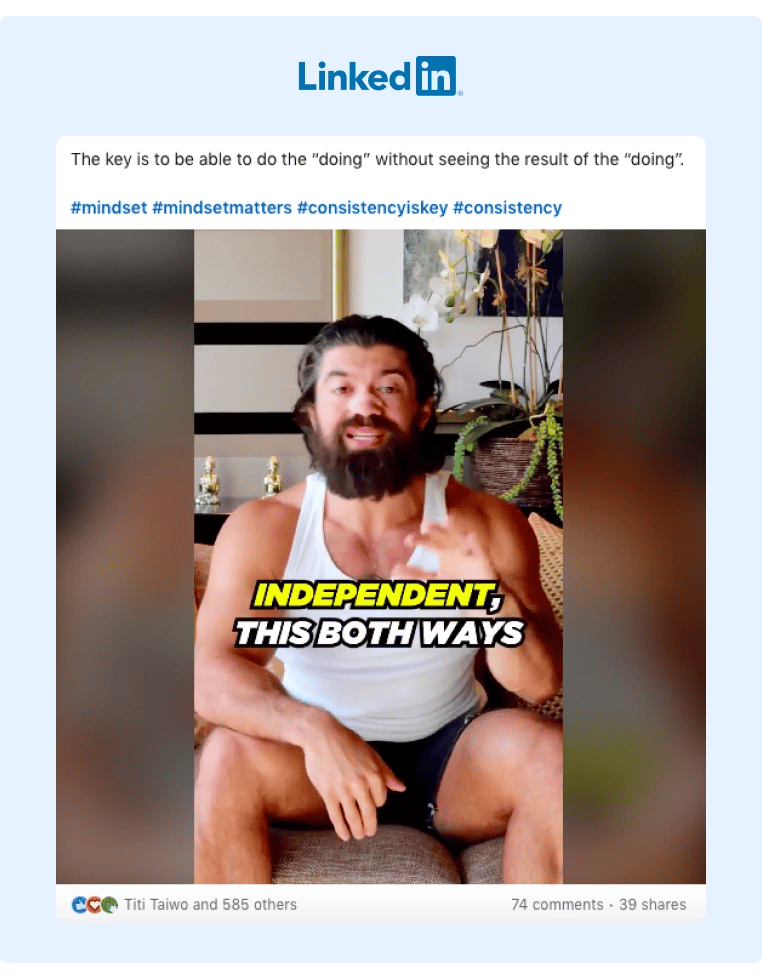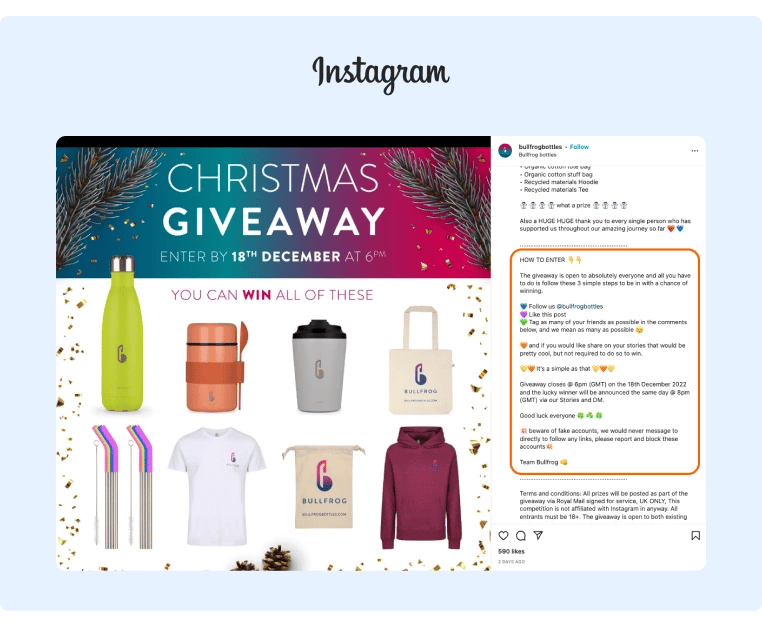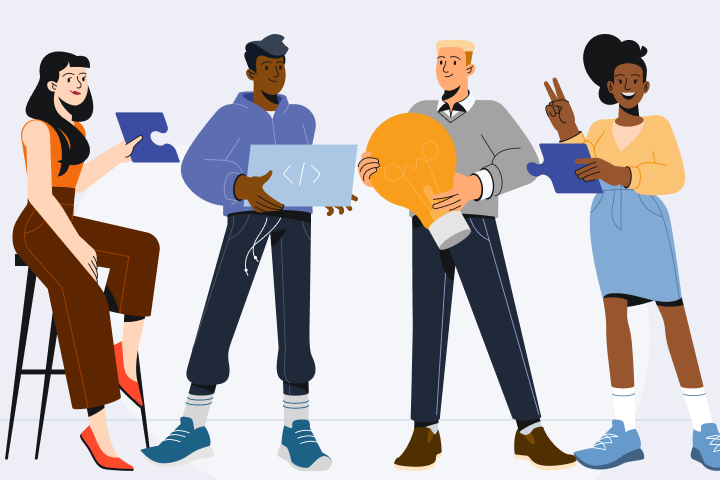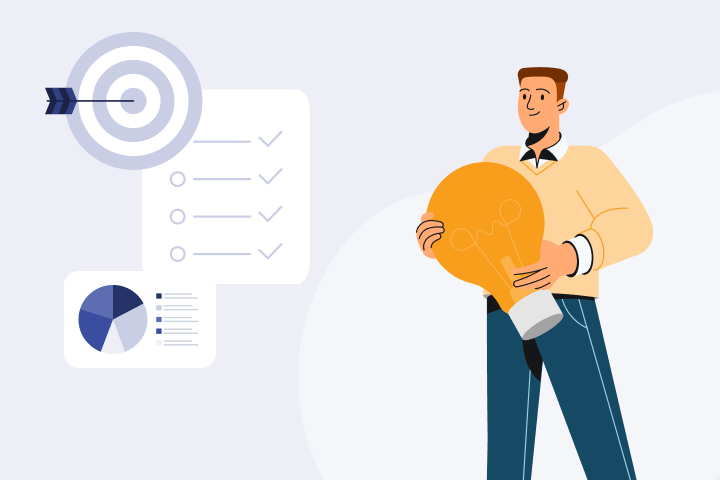How to Increase Brand Awareness on Social Media (Efficiently)
If you’ve been trying to increase brand awareness on social media and it isn’t working, it’s probably because you’re not consistently executing the right tactics.
So we compiled a list of the most effective tactics to increase brand awareness on social media and also provide execution tips for each one so that your new social media strategy can be sustainable.
Let’s jump into it.
1. Leverage Employee Advocacy
One of the best ways to generate more brand awareness is to simply ask your employees to share key company initiatives with their social networks.
If all of your employees chime in, it's relatively easy to significantly increase the brand's organic social reach because your employees' networks combined is likely a magnitude times larger than the company's page's followers.
As an added benefit, you'll probably find that the impressions are much higher quality because they're coming from friends of employees – so the viewer already has a warm introduction to your brand.
In addition, social media posts from other humans tend to naturally generate more engagement than posts from brands because people log on to social media to interact with other people. So employee advocacy is a super easy way to make your brand more humanistic.
Here are just a few examples of how brands have leveraged employee advocacy to level up their social media presence.
Real Example:
Here's one example of an employee brand advocacy post from the marketing agency, Smart Bug:
SmartBug Media used GaggleAMP to run its employee advocacy program, and it had worked out well for them. Just five months into executing an employee advocacy strategy with GaggleAMP, they saw the following metrics:
-
Website traffic from social media increased by 28% month-over-month
-
A 31% month-over-month growth in leads
-
About 28% of the website's monthly social media visits came from employees' networks
Execution Tips:
Unfortunately, coordinating with your team to ensure the right people share the right company initiatives at the right time can be an organizational nightmare.
Many marketing and social media managers tell us that they typically begin their employee advocacy program by sending a company-wide email or Slack message to employees with a request to share a particular brand initiative.
Unfortunately, most employees eventually ignore these mass messages.
To improve participation rates, some managers try sending personalized private messages to specific employees, but this isn't a scalable method.
So instead, we built GaggleAMP.
It makes it easy to assign personalized engagement tasks to specific employees at scale. To ensure participating employees receive recognition (and you can measure the ROI of your efforts) GaggleAMP also tracks participation rates.
Here's a brief overview of how the platform works.
Step 1: Managers Create and Assign an Engagement Activity
To get started, select an engagement activity.
We offer engagement activities for all major social media sites, and the main benefit is that each engagement activity specifies how you'd like the employee to engage (e.g., like, comment, share, etc.).

Once you've selected an engagement activity, you can add specific instructions or even create pre-written text for your employees. By creating specific instructions, employees are more likely to engage as they don't have to think of how to engage or (if you choose to add pre-written text) what to say.
Then, you can assign it to a group of relevant people (e.g., the sales team, the executive team, etc.) or select a few specific people in your company.

This makes it easy to ensure you're only assigning relevant tasks to relevant employees.
Step 2: Employee Receive a List of Relevant Engagement Activities
After you assign an engagement activity, employees receive a notification.
They can then log into their Gaggle and see a list of personalized engagement activities with specific instructions.

As an added bonus, employees can complete most of the engagement activities directly inside the Gaggle and then schedule them to publish at a later date. This way, employees can rest assured that their posts will be published consistently throughout the week, though they only have to devote a few minutes to employee advocacy each week.

GaggleAMP also tracks engagement activity, and the public leaderboard ranks employees by engagement level. This ignites friendly competition between employees to further encourage engagement. The leaderboard also makes it easy for managers to recognize and reward engaged employees.

In addition, you’ll be able to track the ROI of employee advocacy efforts with key metrics like estimated earned media value (EEMV), total clicks, total reach, and more.
To see for yourself if GaggleAMP is a good fit for your company, schedule a demo today.
2. Adopt The Social Platform’s Preferred/New Features
When social media platforms release a new feature, they want to encourage people to use it. For example, when LinkedIn live first launched in 2019, the platform gave more organic reach to those streaming live than the average text-based LinkedIn post.
So for each social media platform you're using, stay up to date with both:
-
That platform's preferred features/content formats
-
New features it is releasing
Real Example:
When LinkedIn live was launched in 2019, Pfizer quickly jumped on the new feature and launched its first live stream. The results were outstanding.
The first live stream outperformed their typical engagement by nearly 5x, generating more comments (1,000 plus) than its previous 60 plus text-based posts combined.

Execution Tips:
The biggest challenge with this tip is staying up-to-date with the latest social media changes.
To solve this (without reading every social media blog that exists), here are a few information sources that can help you stay up to date.
Blogs:
- TechCrunch Social: Learn about recent social media product updates
- Social Media Examiner: They offer a lot of different information on social media, though they also offer a newsletter which you can subscribe to for updates
Social Media Accounts:
- Mark Schaefer (@markwschaefer)
- Ann Handley (@annhandley)
You can also always add a reminder to your calendar to do a quick Google search for platform updates. For example, you can search keywords like "LinkedIn updates 2023" or "LinkedIn feature updates 2023" every month.
3. Collaborate with Influencers/Parallel Brands
One of the easiest ways to get in front of your potential customers is to simply partner with influencers and brands that already have their attention.
You can do this by running a traditional influencer marketing campaign (paying the influencer to post about your brand), or you can partner up to do a content collaboration.
For example, you could do a live stream, webinar, or podcast with a parallel brand or influencer and then post snippets of the content on social media.
Real Example:
Clearscope has several excellent examples of how you can do B2B partnerships with other influencers to get in front of your target audience (and not pay a dime!).

They frequently host roundtable discussions and expert interviews and then post the content on their social media accounts.
Execution Tips:
Executing a collaboration with other social media influencers is relatively easy, though it can be time-consuming. If you need help, you can hire an outreach expert to execute the following steps:
-
Find influencers/brands with similar audiences.
-
Send a personalized outreach to a relevant channel.
-
Record a video and repurpose the content
You can find relevant influencers and brands by asking your current audience (current customers, email list, social media followers, etc.) who they follow. Another great method is to look at popular industry conferences and then reach out to the speakers.
Most speakers attend conferences because they care about growing their brand image and are more than happy to participate in a collaboration.
Finally, look at your competitors – who are they doing collaborations with?
First, discover where the influencer/brand is most active (e.g., Twitter, email, LinkedIn, etc.). If you're reaching out to the brand, be sure to find the right contact.
Your outreach can be something like this:
"I read/heard your (previous collaboration) and really liked (specific thing). Would you consider doing a (webinar/podcast/video)? We would love to promote it to our audience of (statistic) (audience industry)."
Once the collaboration is complete, repost snippets of it on social media. While most people post the full video/interview/webinar recording, we recommend pulling short clips and text quotes as short-form content tends to perform better on social media. You can then tag the influencer in each one to generate maximum reach.
4. Increase Publishing Frequency (Repurpose Your Content)
Unlike blogging, where it might make sense to spend hours creating a single piece of high-quality content, most social media content only lives for a few hours. So if you don't post consistently, your audience will probably forget about you as your social media posts will quickly disappear.
We always encourage you to create quality content, though frequency is also a critical factor for social media success.
So to help you find a balance between frequency and quality, here are some tips:
-
Repurpose content
-
Repost evergreen content
-
Share employee content (e.g., a CEO's post)
Real Example:
Alex Hormozi is an excellent example of an influencer that takes content repurposing to the next level. He records videos and then has a team member chop them up into:
-
LinkedIn videos
-
Podcast clips
-
TikTok videos
-
Instagram videos
Here’s an example of a mindset video he created and then later repurposed on LinkedIn:

It's also an evergreen piece of content, so he can also repost it at a future date.
Execution Tips:
If you don't yet have a great social media content strategy in place, consider interviewing some of the thought leaders in your company and turn on a camera for the interview.
Now that you have great content, you can use a tool like Repurpose.io to extract the best clips and share them on social media.
If you don't have time to do this yourself, you can always use a service that does it for you, like RepurposeHouse.
5. Run Contests
Contests and giveaways are excellent for building brand awareness because, when executed well, they are a great value exchange as the ask of the customer/viewer is relatively small compared to the prize. (Of course, this means that the giveaway needs to be something that your target audience actually wants.)
Another key consideration when running a giveaway is that the prize should be relevant to your target demographic. For example, if you're an ecommerce store selling makeup, the giveaway prize shouldn't be a gift to a store like Nike because that prize is completely unrelated to your target audience.
Instead, a great giveaway would be free makeup because the audience that values that gift is the ideal customer.
In addition, think about how you want to qualify candidates. For example, most marketers require that contestants reshare social media posts to be considered for the final prize, though there are other engagement actions that can generate higher quality brand awareness, such as:
-
Sharing a review/testimonial
-
Creating user-generated content involving the product
-
Tag a friend and comment

Real Example:
My First Million, a popular entrepreneurship podcast, leveraged contests to significantly increase its social media presence on TikTok.
They ran a contest that offered $5,000 cash to creators that made TikTok clips of their YouTube videos. These were the rules:
-
Select a YouTube video
-
Create a TikTok clip of the YouTube video
-
Publish the clip and use hashtags "mfmclip" or "mfmclips"

While the hosts didn't share exact stats, they revealed on the podcast that this contest was the most effective brand awareness campaign they had ever run.
Execution Tips:
Creating a contest is pretty easy:
-
Decide what you want to offer (free product, cash prize, etc.)
-
Decide how you want people to enter the contest (share a post, publish user-generated content, tag a friend, etc.)
-
Track campaign performance
Manually tracking contest performance can be tricky, so instead, consider using a platform that automates the process. Here are a few options:
6. Engage With Your Audience
A super easy way to spread awareness of your brand is simply engaging with your existing audience.
Unlike blogs, podcasts, and videos where the content is largely a single person speaking, social media platforms are unique because people are conditioned to have two-way conversations.
So make sure that you respond to comments and reshare any mentions.
Real Example:
Glossier is a makeup brand that has an incredibly loyal customer base.
Their customers are always posting pictures or memes of the product, and Glossier encourages it by resharing the posts:
Glossier LA opening week mood https://t.co/j4l0VKfmIK
— Glossier (@glossier) November 17, 2021
They've also done a masterful job developing a strong brand personality that fits their ideal audience. You can tell that the brand voice sounds just like a millennial or Gen Z girl talking to one of her friends.
Execution Tips:
Responding to comments is relatively easy, though it can be time-consuming. So if you're short on time, consider hiring an intern or someone on Upwork to do this for you.
You can also use a tool like Buffer, which offers an engagement dashboard to monitor and respond to comments across all social media platforms from one place.
Finally, you can also use a social listening tool like Awario or BrandMentions, which lets you know whenever someone mentions your brand. These tools make it easy to quickly find and reshare any user-generated content across various social media platforms.
7. Promote Your Social Media Channels
You probably already have some following – whether it's an email list, podcast, or blog readers. So rather than scrambling to find new audiences across each social media platform, consider promoting your social media channels to your existing audience.
Objection: My goal is to generate more brand awareness, so why would I want to just target my existing audience?
While this is a good point, there are a few advantages to promoting your social media channels to your existing audience:
-
It helps you stay top-of-mind and nurture them. Most people don't convert on the first touch.
-
Some people prefer social media to other forms of content (like email newsletters), so reaching them on their preferred channel will help you increase engagement.
-
Unlike other forms of content marketing, social media has a network effect. This means that all of your social media followers' friends will see your posts when they engage. This can help you exponentially grow your audience.
Real Example:
We already mentioned that Alex Hormozi is excellent at repurposing content, so it's no surprise that he's also excellent at cross-promoting to different content channels.
For example, when he was trying to grow his LinkedIn presence, Alex asked people on the podcast to go and follow him on LinkedIn.
He has since grown his LinkedIn presence from zero to nearly 37,000 followers in less than a year.

You can listen to this podcast episode to hear how he incorporates an ad-style request for people to connect with him on LinkedIn.
Noah Kagan also has a few excellent examples of this. Each week, he incorporates a particularly popular Tweet into his newsletter.

Execution Tips:
Look at the existing audience you have across different marketing channels and then either:
-
Ask them directly to follow you on other social platforms (like Alex Hormozi)
-
Promote a particularly popular social media post your brand published to your other platforms (like Noah Kagan)
The key to cross-promotion is to do this more than once, as not every single person in your audience consumes every piece of content you produce (e.g., not every email subscriber opens every email). In addition, getting people to commit and follow you on your other social channels might take a few asks.
8. Go Omnichannel
Most people have a preferred social media channel, so one of the best ways to reach more people and generate more brand awareness is to simply post on their preferred social network.
We already mentioned that cross-promoting your social media channels is beneficial, though omnichannel is slightly different as you're posting directly to various platforms rather than cross-promoting them.
For example, if you currently post regularly on Instagram, you can publish the same content on Twitter and LinkedIn.
Going omnichannel is powerful because social media algorithms typically only show your posts to a fraction of your followers. So even if you had the exact same followers on LinkedIn, Twitter, and Instagram, publishing to more platforms increases the likelihood that your followers will see each piece of content.
Real Example:
Eric Siu, the founder of Single Grain, has used the omnichannel approach to significantly increase his brand awareness.
For example, he posted this picture on LinkedIn, Instagram, and Twitter with different captions to promote his mastermind:
Execution Tips:
While taking an omnichannel approach is very similar to repurposing content, the key difference is that repurposing is slightly changing the content (e.g., cutting up clips of a longer video clip), while taking an omnichannel approach is using the exact same content across multiple channels.
So here are a few tips to execute this strategy:
-
Use an omnichannel posting tool like Buffer that allows you to post the same content to multiple platforms simultaneously. However, you should ensure each social post is formatted correctly for the platform on which it will be published.
-
If you do a lot of live streams, you can use a tool like StreamYard to live stream across multiple different platforms at once.
9. Social Listening
There are probably already many people discussing a pain point that your brand solves. So one of the best ways to generate high-quality brand awareness is to join those conversations and provide helpful tips.
While you can comment in the conversation using the brand account, we recommend asking your executives to respond from their personal accounts. This is because people tend to trust other people more than brands, and it makes the social interaction more natural. Once the relationship with the executive exists, it's easy to then use employee advocacy to have the executive occasionally promote brand initiatives.
Real Example:
Here’s a great example of social listening in action where someone asked for a QuickBooks alternative and, after being mentioned by a commenter, Xero jumped into the conversation:

Execution Tips:
The best way to discover people discussing pain points relevant to your brand is to leverage a social listening tool like Awario or BrandMentions and then track the following keywords:
-
Your brand name
-
Your competitors’ brand names
-
Core category keywords (e.g., “marketing analytics tools”)
Level Up Your Brand Awareness Efforts Today
There are plenty of different ways to improve your brand presence, but the main challenge is finding the time and resources to execute these strategies.
While you can hire VAs on Upwork and other freelance websites to do this for you, managing people can be a headache, and it can complicate your workflow.
So instead, we rely on software to automate as much of the social media management process as possible.
If you want to see how GaggleAMP makes it easy to automate the logistics of your employee engagement program, schedule a demo today.













